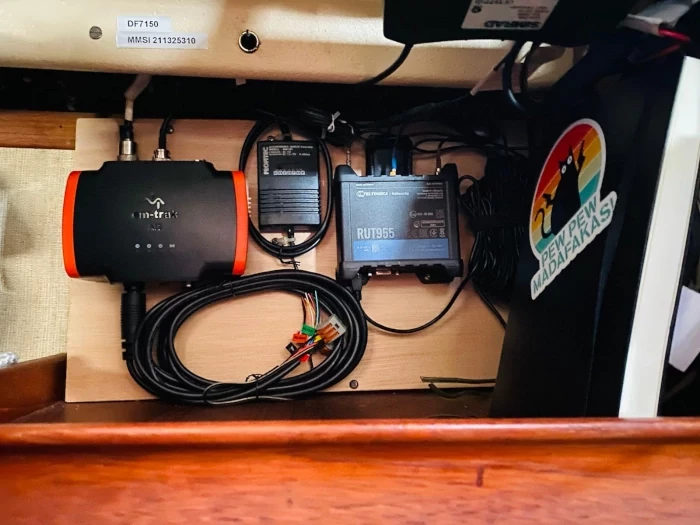
Safety and tracking with AIS
March 8, 2023TL;DR
We have AIS now and you can track us live when we are underway for instance on
- MyShipTracking,
- MarineTraffic or on
- Vesselfinder.
As we knew we wanted to sail on larger waters than the IJsselmeer, one of the pieces of equipment we wanted was an AIS transceiver as a safety feature. This way we can be seen by other ships and we can see other ships – if both are equipped with AIS. A nice bonus feature is also that our ship can be tracked and followed when we are underway.
What is AIS
The Automatic Identification System (AIS) allows ships to automatically exchange information over radio (VHF) with other vessels, as well as with shore-based systems, providing a real-time display of the ships movements in the vicinity. So AIS is essential for improving safety and avoiding collisions.
There are two main types of AIS devices: Class A and Class B.
Class A AIS devices are mandatory for large vessels, such as commercial ships and passenger vessels and not suitable for plessure vessels as ours. They are designed to transmit information more frequently and at a higher power level (12.5 W) than Class B devices (2 W or 5 W), allowing them to be detected from greater distances. The tranceiver operates using SOTDMA. Class A devices also provide more detailed information about the ship and the current travel.
Class B AIS devices are typically used by smaller vessels, such as pleasure boats and fishing vessels. These devices provide less detailed information, but still include essential vessel data, such as the vessel’s name, call sign, MMSI number, speed, and course. There are now two different modes for Class B transceivers: the carrier-sense time-division multiple-access (CSTDMA) system, and the system that uses SOTDMA (as in Class A).
SOTDMA
SOTDMA, or Self-Organizing Time Division Multiple Access, is a newer technology than the CSTDMA. On a Class B device it is better than CSTDMA in terms of the frequency and power level of transmissions (uses 5 W instead of 2 W), but it uses a different method of transmitting data. Unlike the CSTDMA, which uses fixed time slots for transmitting, SOTDMA organize their slots for itself (hence the name) and therefore their tranmission are also prioritized within the system.

Considering the features
AIS devices can come with a range of features and capabilities beyond their basic transmission and reception functions. Some of these features we considered a must have:
- Internal Antenna Splitter: This feature allows the to directly connect the antenna into other radio devices, such as a VHF radio. The splitter provides a shared use of one antenna and eliminates the need for a separate AIS antenna and can help reduce clutter on the boat’s exterior and makes an installation easy.
On the other hand an extra antenna can be used as redunancy system for the VHF in case of need.
- WiFi Access: Some AIS devices include WiFi capabilities, allowing them to connect to smartphones, tablets, or other WiFi capable devices. This feature allows us to view AIS data as an overlay on a mobile device with a navigation app (Navionic boating app, AV Nav, OpenCPN etc.).
- GPS Integration: For providing accurate position data that is shared with other vessels it is useful the device has own integrated GPS antenna and also the possiblity to connect an external GPS antenna.
- Silent Mode: Some AIS devices include a »silent mode« feature, which allows vessels to turn off their AIS transmissions temporarily while keep receiving data. This feature can be useful in situations we want to avoid tracking (you never now…).
Choosing the device
In the end we could/would choose between two devices:
The German Weatherdock easyTRX3 was not available at the time, so we bought the British em-trak B954.
Installation was straightforward, despite the annoying fact that the configuration software (PROAIS2) is only available for Windows OS (and MacOS I think).
[Disclaimer: Some links lead to Amazon. We receive a small commission on purchases. However, there are no additional costs for you.]